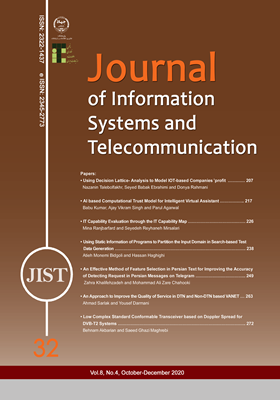-
-
List of Articles
-
Open Access Article
1 - Using Decision Lattice Analysis to Model IOT-based Companies’ profit
Nazanin Talebolfakhr Seyed Babak Ebrahimi Donya Rahmani -
Open Access Article
2 - AI based Computational Trust Model for Intelligent Virtual Assistant
Babu Kumar Ajay Vikram Singh Parul Agarwal -
Open Access Article
3 - IT Capability Evaluation through the IT Capability Map
mina ranjbarfard Seyedeh Reyhaneh Mirsalari -
Open Access Article
4 - Using Static Information of Programs to Partition the Input Domain in Search-based Test Data Generation
Atieh Monemi Bidgoli Hassan haghighi -
Open Access Article
5 - An Effective Method of Feature Selection in Persian Text for Improving the Accuracy of Detecting Request in Persian Messages on Telegram
zahra khalifeh zadeh Mohammad Ali Zare Chahooki -
Open Access Article
6 - An Approach to Improve the Quality of Service in DTN and Non-DTN based VANET
Ahmad Sarlak Yousef Darmani -
Open Access Article
7 - Low Complex Standard Conformable Transceiver based on Doppler Spread for DVB-T2 Systems
Saeed Ghazi-Maghrebi Behnam Akbarian
-
The rights to this website are owned by the Raimag Press Management System.
Copyright © 2017-2025







